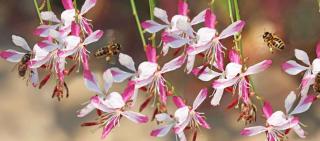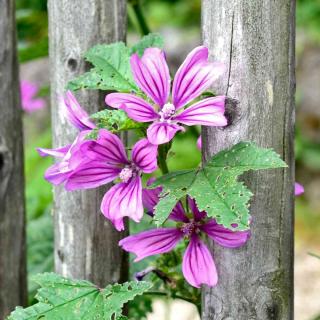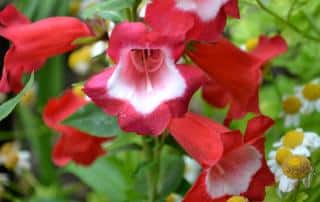

How to flower a garden without spending a fortune? Easy fast-growing perennials won’t need much care and will bloom for a long time. Every year, you’ll have the pleasure of seeing them thrive. They may even surprise you as they spontaneously self-sow in new spots of the garden.
Make the most of the beginning of spring to transfer your speedy-growth perennials from their nursery pots to the ground. As soon as the soil isn’t frozen anymore, these flowers can usually cope with a wet and aerated substrate that will favor deep root development.

Blooming extends from spring to fall. White flowers, with 4 upright petals that are very similar to the wings of a butterfly, appear along the stems in a surprising ballet. No need to deadhead or remove wilted flowers, no fruiting to worry about, and, better still, no need to water anymore after a short while. The light blooming and neutral colors will help a nearby lily of the Nile or peony truly shine.
The pink cultivar with violet leaves, Gaura lindheimeri ‘Siskiyou Pink’ grows more slowly and smaller than others, it’s perfect for a composition in a large container together with other plants. ‘Corries Gold’, for its part, is an elegant cultivar with its yellow-mottled foliage.
Three months are enough for a small nursery pot plant to reach the venerable shrub size of about 5 feet tall and 3 feet across (1.50 m x 1 m). You’ll find mallow plants in the “perennials” section of garden stores, since it belongs to the softwood shrubs group. 
Pair its large pink or white flowers with annual cosmos to extend the blooming of the flower bed up to the first frosts, or surround them with landscaping roses that will highlight their beauty.
Several shades of pink are available, from the pure white blooming of the ‘Ice Cool’ lavatera (not very hardy) to the deep wine-colored pink of the ‘Burgundy Wine’, with, in the middle, the romantic pastel pink of the ‘Candy Floss’. Less vigorous forms (2-3 feet or 60-90 cm) such as the ‘Barnsley Baby’ mallow or the ‘Chamallow’ variety make it possible to grow these in containers.
Feel free to tie your mallow to a lattice along a sun-filled wall, even near the sea. As time passes, keep a few branches that, as they thicken with the years, will bear the weight of the structure on their own. Older clumps tend to send offshoots out from the roots, though not so much that it becomes invasive.
We usually think they’re very fragile because of the exuberant sophisticated flower petals and their semi-evergreen leafage, but they’re actually quite resilient. Penstemon, also called beardtongue, are highly resistant to drought. A downside, however, is that they really need rich soil and will have trouble coping with temperatures lower than 10°F (-12°C). The ground must drain perfectly. If winter is cold and wet, you’ll have to protect the stump with a thick layer of straw or dead leaves under a sheet of plastic tarp.

That said, some pure Penstemon species are still much hardier than these hybrids. They can resist colds as intense as -4°F (-20°C):
Do go ahead and cut spent flower scapes back to the ground to trigger a second wave of blooming. Divide the clumps in spring.